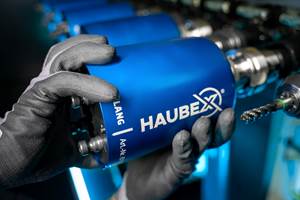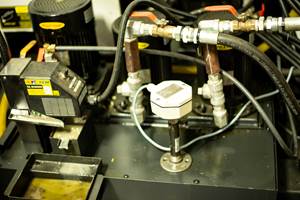Flexible Automation Process Helps Shop Reduce Costs
Despite hitting production goals, this shop had trouble meeting customer cost targets. It needed further automation. After purchasing Fanuc robots to service its flexible manufacturing system (FMS), the company has reduced costs enough to pay back its investment.
Share





Machining castings into precision components can be quite a challenge. In addition to traditional machining and handling issues, global competition can put pressure on shops to keep prices down. Faced with these issues, TMF Center, a Williamsport, Indiana-based manufacturer of components for the construction equipment and trucking industries, developed a long-term strategy for using automation to develop and manufacture tight-tolerance parts and achieve aggressive cost targets.
With 260 employees and two plants, TMF manufactures machined fabrications, precision parts, machined flat barstock and machined steel and ductile iron castings for the heavy OEM market. One job required machining a cast variable valve actuator for a highway truck engine on all six surfaces from many angles. To avoid multiple setups that could increase part variability, the shop used standalone, five-axis Mazak Variaxis 630 machining centers from Shelton Machinery that enabled a three-step machining process.
The first operation machined locating details and rough features on the cast part. The second operation machined all topside surfaces before the part was flipped for the third operation and final machining. As production grew, the company installed a Mazak Palletech flexible manufacturing system (FMS) to minimize labor content and achieve production schedules.
First-generation machining and second-generation prototyping was achieved simultaneously on the initial line. However, the second-generation design, a combination of the variable valve actuator and an engine brake, was more complicated. The newly designed part required more extensive machining and a higher production volume, prompting the company to purchase an additional FMS Shuttle System as well as more machining centers.
Still, despite hitting production goals with tooling refinement, hard work and manual operations, the shop couldn’t meet customer cost goals. Because the new design incorporated performance benefits and cost savings, customer demand mandated a quick transition period. Further automation was required, and that automation had to work with the existing systems.
So, the company purchased a Fanuc Robotics M710iBT Toploader robot to service its FMS. With travel length of 26.5 meters and a 70-kilogram payload, the robot could traverse the distance across the machining lines to deliver parts. The robot’s wrist could flip parts over between the second and third operations, and its six axes could tolerate any out-of-alignment or out-of-square conditions of the FMS.
In addition to the robot, the company purchased a custom hydraulic clamping system that could couple and decouple to the FMS pallet. Designed and delivered by Busche Engineered Tool Division, the hydraulic clamping system allowed more automation and greater process repeatability than the original FMS’s manual nut drive system. Fanuc Robotics engineers worked with Busche engineers to develop an interface between the robot, the automatic clamping and the Mazak FMS.
TMF Center also worked with Fanuc engineers to define a post-machining deburring process. A floor-mounted Fanuc Robotics R2000iA robot manipulates the part around a stationary carbide deburring cutter to eliminate large burrs from the finished parts. Barry Henderson, Fanuc Robotics controls engineer, used the robot’s Remote Tool Center Point function to allow easier teaching of the deburr and blow-out positions. Fine burrs are removed later in the process by a thermal deburr machine.
The thermal deburr process helped in that the smaller burrs did not have to be removed by the robot. However, it also complicated things in that any loose chips on the part or in the part had to be removed. Loose chips often became dislodged and fused to the casting, creating a scrap component. Thus, operators had to probe and blow out all the part’s holes and cavities. To mimic this manual approach, Fanuc and TMF Center developed a compliant air-pipe hole-blowout system to force out embedded chips through air pressure.
The overall process works like this:
- Operators manually load the part onto a Mazak Variaxes 630 machining center for the first operation, which consists of the rough machining of locating surfaces on the raw casting. Operators then load the part onto a conveyor for the infeed to the Fanuc M710iBT Toploader robot.
- The robot uses a dual hand tool to pick up the part and load it onto a staging station near the FMS shuttle for line 1 or line 2.
- The robot interfaces to the hydraulic clamping system to load and unload the part for the second and third operations. After the third operation, the robot transfers the part to an outfeed conveyor.
- A Fanuc R2000iA robot removes the part from the outfeed conveyor and uses a carbide deburr tool to eliminate large burrs. It then probes the openings on the part and blasts out embedded chips. Finally, the robot marks each part for time, date and machining operations to allow traceability and quality tracking by both TMF Center and the customer.
- The robot places the part back onto the outfeed conveyor for manual unload and inspection prior to thermal deburr and washing operations.
The combination of a toploader guarding solution and the FMS loader system allows the company to service or maintain any of the machines or the loader while still running the balance of the system. The system can achieve high production and machine utilization rates while supporting tool setup functions, the company says.
This full automation solution has been installed and running since late 2005. The company says it has produced an incremental reduction in scrap and a reduction in labor costs that have paid back the automation investment two-fold.
Related Content
Cutting Part Programming Times Through AI
CAM Assist cuts repetition from part programming — early users say it cuts tribal knowledge and could be a useful tool for training new programmers.
Read More4 Steps to a Cobot Culture: How Thyssenkrupp Bilstein Has Answered Staffing Shortages With Economical Automation
Safe, economical automation using collaborative robots can transform a manufacturing facility and overcome staffing shortfalls, but it takes additional investment and a systemized approach to automation in order to realize this change.
Read MoreUsing the Toolchanger to Automate Production
Taking advantage of a feature that’s already on the machine tool, Lang’s Haubex system uses the toolchanger to move and store parts, making it an easy-to-use and cost-effective automation solution.
Read MoreManaging Coolant with Skimmers, Refractometers and More
Bacteria-infected coolant harms machines and sickens machinists. Coolant management technologies like skimmers and automated systems counter this tendency.
Read MoreRead Next
5 Rules of Thumb for Buying CNC Machine Tools
Use these tips to carefully plan your machine tool purchases and to avoid regretting your decision later.
Read MoreRegistration Now Open for the Precision Machining Technology Show (PMTS) 2025
The precision machining industry’s premier event returns to Cleveland, OH, April 1-3.
Read MoreBuilding Out a Foundation for Student Machinists
Autodesk and Haas have teamed up to produce an introductory course for students that covers the basics of CAD, CAM and CNC while providing them with a portfolio part.
Read More











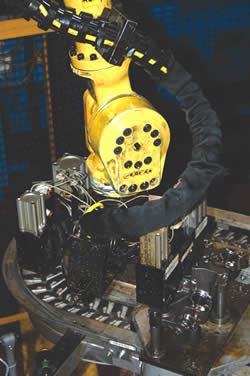
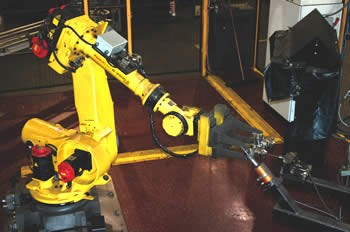
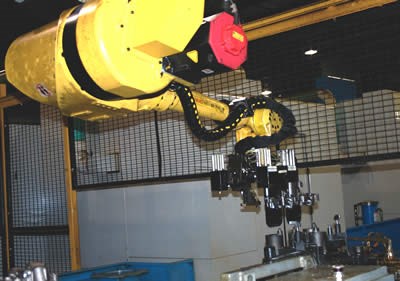







.png;maxWidth=300;quality=90)









